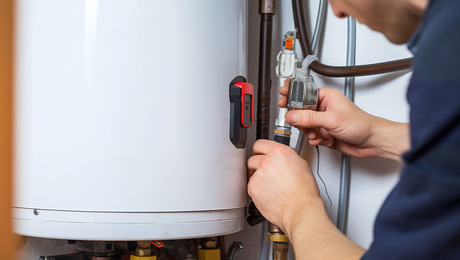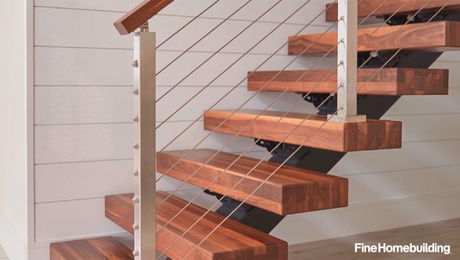*
is it neccessay to put a water barrier behind vinyl siding?? Our church is putting up a storage shed and the sheathing is OSB, they plan on putting the vinyl siding right over the OSB. i thought u had to put a barrier like tyvex or roofing paper to keep the moisture off the OSB.
they say they dont need to just because its a storage shed, and its not necessary because there are many houses built today that have vinyl siding on OSB and there still standing.
So whos right???
thanks


















Replies
*
Who's right? Definately NOT "them". Vinyl siding is a great big seive. Meaning, use felt or Tyvek. It's such a small expense, not a place to save a buck.
*At $7/roll, use the tar paper.
*thanks,the problem is that many of the people are "old school" in there thinking. They think that because it was done that way in the past, it should still be done that way. They also think that the vinyl siding will stop all the water.
*Apparently they're not all that "old school" if they want to use vinyl siding instead of something decent. These guys are right, vinyl siding has no ability to shed water by itself. I would suggest that you ask everyone to toss an extra buck into the plate next sunday and that should more than cover the extra cost of doing it right. (Heck, depending upon the size of the congregation, a quarter per person would probably do it.)
*Jon ,As to their comment i there are many houses built today that have vinyl siding on OSB and there still standing. Tell them , "the studs hold up the house , so what's your point"The public is ignorant when it comes to vinyl siding,I had a guy tell me the other day that vinyl siding was water tight. When I asked him how could he say that.. he replied "cause it has all that J-channel to keep the water out." Boy what an idiot.Resonable Ralph
*Jon: perhaps this is a Baptist church that sees it as a water baptism? If I were you I'd be a good guy and buy a roll of #15 felt and tack it up.
*If these guys were from the "old school", they'd be insisting on the felt paper under the vinyl. Pay close attention to the areas that need flashing (like door frame, corners, etc...) Vinyl ain't final. It moves about 1/4" when expanding and contracting. If vinyl siding and accessories were 100% waterproof, there could not be any movement allowed. Also, vinyl siding has a tendency to create condensation on its backside due to temp change variations between the vinyl and the surface behind it. Hard, wind driven rain will also get behind the siding via every nook and cranny that it can. This is why vinyl siding has weep holes, or drain holes in the bottom of each section of siding. If these guys persist in their idea that the vinyl doesn't need a barrier, ask them about the weep holes. If the siding has a means for excess moisture to escape (although it doesn't work all that great), then the siding manufacturer has to know that moisture behind the siding is a given. Ask these guys why the siding manufacturer knows this, but not them.Be nice, though.James DuHamel
*thanks,most of these people are seinor citizens, they are not contractors, builders or architects. they want to do everything the way it was "back in my day". i dont think they will listen to anyone because theyre "older and wiser"they also said that the overhang from the roof will keep all the water off the vinyl so building wrap is unnecessary.they are doing this shed on a tight budget, but i know they could afford roofing paper or tyvex, its not that much money.I would be willing to bet that they have not and never will read the instructions for the vinyl siding.When i told them that Vinyl siding doesnt keep out water, they gave me a very odd look like i was crazy. I think they think that the vinyl is a watertight barrier.I wont even get into wheather the flashings in right, they said thats what the roof overhang is for.oh and its a presbyterian church,
*I wouldn't recommend doing it, but there is a growing body of evidence to suggest that a drainage plain need not be installed behind vinyl siding.Joe Lstiburek and his folks have done tets where they dumped lots of water between the siding and the OSB. The result was that the siding had good adhesion and capillary action and within 2 feet of the intrusion the water had been wicked off the OSB by the siding and drained away to the J-channel. They then built a few hundred test houses to try this approach. This was five years ago, and I believe they are pulling the siding off these houses soon and will be reporting the findings.This is definetly not an "old school" approach.-Rob
*rob.... bs...it sounds like you are condoning vinyl without felt or a drainage plainvinyl siding needs good flashing details and a drainage plain behind it...<<>> my ass...when and if the test houses are stripped .. then present the data.. this is just conjecture at this point... sounds like the same crap the EIFS industry got itself into...i'm surprised at you advocating vinyl without felt and flashing details...
*i think that the Vinyl siding industry needs to educate the public about the proper instalation of vinyl siding. I have worked on many Habitat For Humanity houses in our town, all of them have vinyl siding over OSB, with no water barrier. When i asked the director at HFH if they put on tyvex or tar paper, he said "no its not needed". When people go and volenteer at HFH they see how they build houses. Then they say "if its good enough for HFH they its good enough for me". Too many people believe HFH does FHB.
*I'm guessing that if Mr. L dumped the water behind the vinyl, even if capillary action pulled most of the water back off the OSB onto the vinyl, you'd still have damp OSB, wouldn't you? And damp OSB (or plywood or whatever), ain't good in my mind. I've installed a lot of vinyl, and like an idiot, read the instructions...all of them I've seen say that you need something behind the vinyl to protect the sheathing. You guys put felt or something behind other types of siding, right? Why would vinyl be any different, particularly when Certainteed states in it's instructions that vinyl is not going to keep all water out? Perhaps I'm missing something, and I know I'm not as literate as most of you are about building science, but when you have a product you know will allow water behind it, there has got to be something to protect that sheathing back there, particularly when we see so many articles in JLC and FHB about exterior details "in case" of water intrusion. You might not like housewraps, and that's fine, but at least felt or another product should be used in my opinion.
*ok I guess I am old school, because I will not accept new school thinking that nothing is needed behind vinyl and esp. OSB. OSB is one of the last products I want exposed to any kind of water. I agree with one of the earlier writers. If they cant afford it, and it is a small utility building , maybe you can be the nice guy and suprise them. even 2nds from the lumberyard will be better then nothing.Also how big is the shed. In our county, anything bigger then 10needes a permit, if it should have a permit then will the inspectors allow you to put vinyl on without a barrier.I restore and remodel too many old homes to see the damage caused by water, and the worst is always behind vinyl
*I think it's funny how these guys building this shed are "old school", yet it's sheathed in OSB and covered with vinyl.
*Vinyl is certainly not "new school" in the South -- been in routine use here for at least 25 years. I would not suggest Tyvek because it is marketed as a "high tech" product, and a roll of it IS expensive. I used it on my house, but considering all I've learned here, I would probaby use felt if I was doing it over.I've worked with older folks at church for years, and I'd take this approach. "OK, it's just a storage building. But spending a little extra for some felt can only help, and do we really want to take a chance on builing a storage building for the Lord that leaks?"
*On has to assess the risk of water damage and the consequences of water damage. If it is a shed, then regardless of the risk the consequences are small so no barrier is needed. At worse they tear the siding off, put tyvek on and reside. I have vinyl on my house and my daughter's house. Both have tyvek because of the consequences. (I am not up to residing 2 stroy houses.)
*Mike, please tell me what the first sentence of my post said. I'll repost it here for you....“I wouldn't recommend doing it, but there is a growing body of evidence to suggest that a drainage plain need not be installed behind vinyl siding.”Do I sound like an advocate?As far as the rest of your insults go – whatever, just read the disclaimers before you jump on me again. I also think we will look back on EIFS in rain-heavy climates as an experiment gone awry.I presented it just FYI, but I guess that point was missed.The other point of the study was that the J-channel conducts the bulk of the water away and that more attention need be paid to the J-channel. Does anyone care to argue that point?My impression was that if this study proved to be true, then you could put a length of felt under each window, or each interruption in the siding. This would protect the OSB and the water would be wicked away before it got to the bottom of the felt.I guess I really don’t care to argue about research or facts, but please keep in mind that the attitude I get and the statements I hear people make on this site are not unlike the ones made when the industry went from solid boards to plywood or from open, vented walls to insulated ones. There was lots of resistance at first from people unwilling to learn. But the facts proved out. Many of the arguments I hear people make against a change are also completely unsubstantiated with facts. Take the TYVEK post for example. How many of the people posting there have ever done a single damn blower door test? How many have even seen one? How many even know what one was? But these same people will defend the product even though they have never personally verified or witnessed the air tightness improvements. If they had actually done some pressure diagnostics on a house they’d realize that the last place to worry about airtightness is the walls!Oh well, enough of my sermon.-RobP.S. – Sorry I got all wound up, but Mike lit into me for no good reason.
*Some people build a certain way because they are lazy. Some because they scrimp every penny from materials outlay so they can instead add it to their bottom line. Someone else sees these practices and it suddenly becomes "the way it's done.""Most houses" may indeed have vinyl directly over OSB...then again, "most houses" start falling apart 4-5 years after they are built.Use #15 paper. Period.
*Rob,i The other point of the study was that the J-channel conducts the bulk of the water away and that more attention need be paid to the J-channel. Does anyone care to argue that point? I'll DISCUSS it with ya, but I ain't up for arguing.The manufacturer of the vinyl siding (doesn't matter which one, they all do it) has added drain channels/weep holes in the MIDDLE of each siding panel (as well as closer to the ends) because they know that moisture buildup on the backside of the panels will be a problem. If they thought for a second that the water would be channeled to the J channel, and removed in this manner, they would cut their production costs and forego the weep holes. They know, as well as everyone in the field who has had to deal with it, that water penetration behind the siding will occur. Not could occur, or might occur, but WILL occur. I don't care how much attention you pay to the J channel, finish channel, corners, or seams. Water WILL pentrate behind the siding. If the sheathing behind it is not protected in some manner, it will get wet. Maybe not soaked, but it will get wet. OSB is a bad product when it comes to water contact. It just can't handle it. ESCPECIALLY if it has no way to properly dry out. Heck, priming the sheathing would be better than nothing at all. Another aspect to remember is that 95% to 98% of ALL vinyl siding failure is related to improper installation (check with the manufacturer's reps to verify). This means that an awful lot of people are installing the siding and accessories WRONG. Since it happens so often, why not add a little protection for the sheathing by installing felt, house wrap, or whatever. Cheap insurance. It costs a lot to remove the siding, remove the rotten sheathihg (and in most cases some of the framing) and then replace it all with new. Do it right the first time, add a little insurance, and never worry about it again.Just a thought...James DuHamel
*just wanted to let u guys know that the building was sheathed with OSB on the 29th of april. It has sat uncovered sence. They are waiting for the trusses, which will come on june 9th.we have had alot of rain, and the shed is in the shade most of the day. I doubt that they will get to siding it for at least another week, if not longer. Anyone want to warrenty this building??? LOL
*Buildings sit a lot longer than that if the weather ain't cooperating!-Rob
*When a great job is done on J- channel around a window, tell me, "where does the water go"? Come on! This is kindergarten stuff.
*Waiting six weeks for trusses? Have these guys ever hear of "planning" -- it's in the Bible you know. Baptists put up a lot of churches (the whole thing) in a day. Jehova's Witnesses do most all theirs that way. Maybe you need to convert? :)
*
is it neccessay to put a water barrier behind vinyl siding?? Our church is putting up a storage shed and the sheathing is OSB, they plan on putting the vinyl siding right over the OSB. i thought u had to put a barrier like tyvex or roofing paper to keep the moisture off the OSB.
they say they dont need to just because its a storage shed, and its not necessary because there are many houses built today that have vinyl siding on OSB and there still standing.
So whos right???
thanks